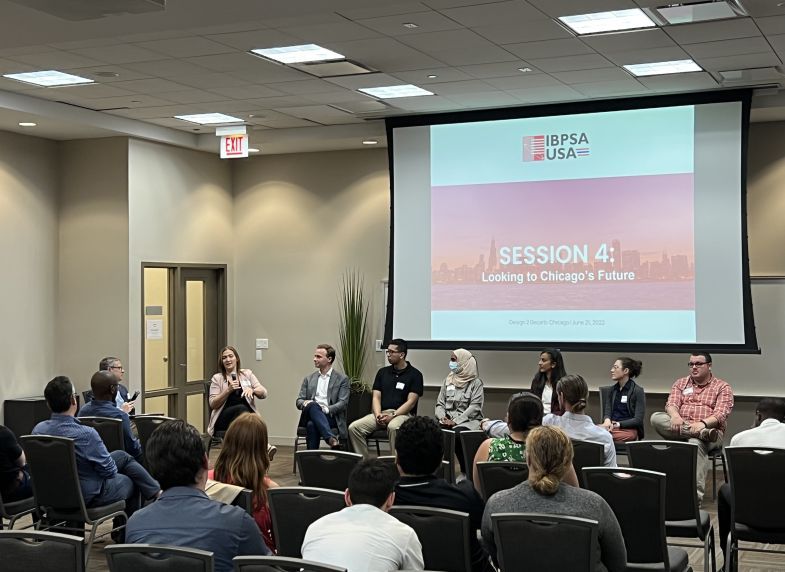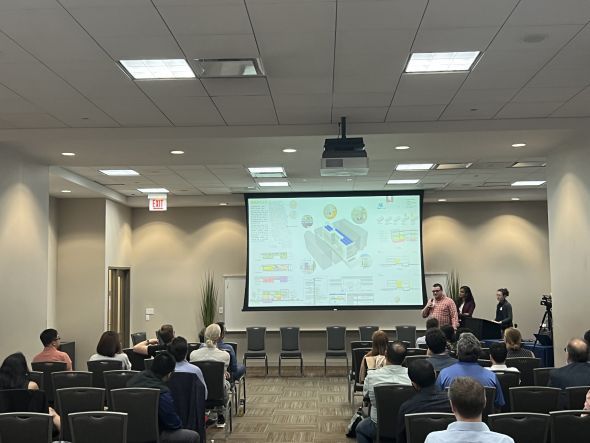
In this week's blog, Phius Project Certifier Al Mitchell discusses his experience attending and presenting at a recent building performance conference in Chicago.
The Chicago Chapter of the International Building Performance Simulation Association (IBPSA) hosted a one-day Design 2 Decarb mini-conference in Chicago on June 21 which I had the distinct pleasure of attending and presenting at as part of the closing panel.
Originally intended as a gathering to get Chicago's building energy modelers in one room to share ideas and network, the conference was put on pause due to the global pandemic. As industry attitudes changed during the two-year shutdown and people had time to reflect on what the impact of the built environment should be, there was a large ideological shift in the mini-conference, including the renaming of the event to "Design 2 Decarb."

As an avid energy modeler and employee of an energy model-based standard, I was glad to attend the conference, as it was organized as a single-room conference, which is nice in the respect that you get to see every presentation. There were four panel sessions: Chicago & Illinois Sustainability, Energy Efficiency, and Decarbonization Policy, Calculating Chicago’s Carbon Footprint, Chicago’s Best Practices, and Looking to Chicago’s Future (the one in which I participated). These presentations were bookended by keynotes from Gordon Gill of Chicago-based architectural powerhouse Smith + Gill, and Angela Tovar, Chicago's Chief Sustainability Officer.
I would like to highlight the strong Phius representation in the Chicago's Best Practices panel with architects Doug Farr and Tom Bassett-Dilley presenting about retrofit decarbonization projects in which they are involved. They expressed how the implementation of passive building principles was crucial to the success of these projects and how the envelope upgrades drove the reduction in mechanical system size, solved existing deficiencies (Tom's sealing solved a squirrel invasion problem), and improved occupant comfort and interior environment quality.
It was an honor to present in the Chicago's Future panel along with other current and former students of the Illinois Institute of Technology (IIT). We shared our projects and experience as part of the Department of Energy’s Race to Zero and Solar Decathlon Design Challenge competitions.
In all honesty, my participation in these competitions changed the direction of my budding career by introducing me to energy modeling and concepts of high-performance design. During the design and planning phase for these competitions, we were able to engage with industry partners. For the 2017 Race to Zero, we were working on an infill single-family project in Chicago, and got a visit from James Ortega and Lisa White from Phius. I distinctly remember their spiel on windows and envelope air tightness, and frankly I thought they were crazy. But we implemented many of the passive principles they introduced to us in our design and were able to secure second place in our category.
For the 2019 competition, I worked on the project in parallel to my Phius Certified Consultant (CPHC®) training, and continued to apply the core of the standard to our design. I met Phius Co-Founder and Executive Director Katrin Klingenberg at the presentations for the competition in Golden, Colorado, and the rest is history.
I think this conference was a good, hyperlocal event that will inspire other groups to set similar things up, and encourage networking, idea sharing, and the ever-coveted human interactions. The refocusing on decarbonization is a welcome paradigm shift, and will continue to shape our professions going forward.
The recent Phius rebranding included a new motto, "Building a ZERO Carbon Future" and the work and enlightening technical sidebar discussions at this conference reflected that mission, and showed strong interest in a collaborative effort to move toward that future.
More information about the conference can be found here, and the recordings are available on the IBPSA Youtube page.
